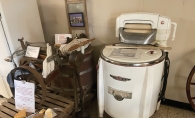Washers and dryers can be pesky machines. Not only are they often large and
overbearing, they can be energy hogs. Maple Grove Senior High (MGSH) senior Jack
Egert noticed this and set out to find a sustainable solution. Enter: “Passive
Reclamation of Unexploited Energy,” a project aimed at recovering lost energy in
the process of cleaning clothes. Earlier this year, his invention received
recognition both on the state and international levels.
Egert has always been a forward-thinker and inventor; this wasn’t his first
time on the awards circuit. As an eighth grader, Egert competed in the regional
science fair and advanced to I-SWEEP (International Sustainable World Project
Olympiad), an international science fair in Houston, with a different
sustainable invention for which he earned a bronze medal. He called on that
experience for this invention, which has been five years in the making.
Egert noticed that any time his family’s dryer was running, there was wasted
energy flowing outside of their home. He decided to capture that energy. “I
thought, ‘how could I make this as uninvasive as possible and efficient,’” Egert
says.
His device, a 1-inch insulation board platform, cost only $22 to construct.
Whenever the dryer runs, it heats up an insulated box that has cold air running
through it. Egert’s invention fits between the washer and dryer and collects the
excess condensation, recovering 15 percent of the energy from the electricity.
Egert’s research backed up his theory. He discovered that 71.8 million U.S.
households have a washer and a dryer, which costs around $262 to operate each
year. Egert’s invention saves each machine $40.74, or nearly $2.9 billion
nationwide.
Chemistry teacher Dale Swanson says Egert talked with him about the project.
“He likes to think outside of the box,” Swanson says. Egert competed in the Twin
Cities regional science fair at the end of February and says he was “a black
sheep” in the competition. He was the only competitor from Maple Grove and won.
“I jumped up, threw my arms up and was really excited,” he says.
He also competed in the national science fair at the end of March and
returned once again to Houston for I-SWEEP, his third international fair in five
years. Egert earned recognition from the United States Marines for his
sustainable idea. He also won the 3M Inventor Award, and with it came the
invitation to talk with 3M scientists and engineers about his project.
“We are extremely honored that our student has made it into the national
competition. I know he has worked very hard,” says MGSH principal Sara Vernig.
“We are just really proud of him.”
Egert learned of the importance of renewable energy when he first competed at
the national level where health care and renewable energy were the two biggest
categories. “I think everyone is looking on the large scale, at solar, nuclear
and wind energy. No focus is drawn to the small scale: the home,” he says. “Some
of the smallest things have the biggest difference.” Egert says he believes that
renewable energy is something that scientists and inventors will continue to
focus on. With hopes of studying sustainability in college, he counts himself
among them. Egert plans to take a gap year before starting school to build
funding and produce a commercially available version of his invention within 18
months.
&
Egert earned the 3M Inventor Award this year, which includes an invitation to present to
approximately 300 scientists and engineers at 3M’s corporate offices.









